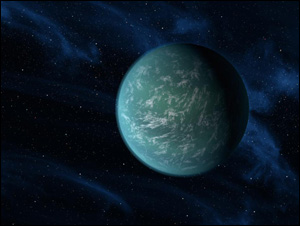 The term ‘Goldilocks planet’ refers to any planet in the Universe that lies within the habitable zone of a star. The habitable zone itself is an area of space around the star where temperatures are sufficient to permit the existence of liquid water on the planet’s surface. The idea is that if there is liquid water, life can exist.
The term ‘Goldilocks planet’ refers to any planet in the Universe that lies within the habitable zone of a star. The habitable zone itself is an area of space around the star where temperatures are sufficient to permit the existence of liquid water on the planet’s surface. The idea is that if there is liquid water, life can exist.
The Copernican Principle
The notion is based on the Copernican Principle that the Earth is not unique in the Universe and that other Earth-like planets exist. Goldilocks comes from the fairy tale ‘Goldilocks and the Three Bears’. A little girl explores the bears’ cottage and chooses between three bowls of porridge, chairs and beds to find which item is “just right”.
The Goldilocks planet in the habitable zone should be similar to the Earth with a solid surface. Gaseous planets such as Saturn or Jupiter are not thought to be capable of sustaining life. Even if an Earth-like planet orbits within the habitable zone of a star, it may still not hold life.
Kepler’s search for the Goldilocks Planet
NASA launched its Kepler spacecraft in 2009. Named after the 17th century German astronomer Johannes Kepler, its mission is to observe over 150,000 stars near the Cygnus Constellation. The spacecraft has a 0.95-metre diameter telescope called a photometer. The telescope’s field of view is 105 square degrees, compared with just one square degree for most astronomical telescopes.
Kepler trails the Earth as it orbits the Sun and views the same star field throughout its mission and watches for transits. These are moments when a planet passes in front of its star and temporarily causes a small change in the star’s brightness. This change may last between one and 16 hours. NASA calculates the planet’s size from the period of its orbit. As of February 2012, Kepler had discovered 1,790 host stars with a total of 2,321 planet candidates. Of these, 61 planets are confirmed as Earth-like planets in a star’s habitable zone.
Some gaseous planets discovered by Kepler have Earth-like moons. Astronomers working at the European Southern Observatory at the La Silla Observatory in northern Chile explore the skies through a 3.6-metre telescope. It has a high precision echelle spectrograph called the High Accuracy Radial Velocity Planet Searcher (HARPS) and is the world’s most successful planet finder.
HARPS has discovered over 150 exoplanets – planets outside our Solar System. One of these, HD85512b, is in the Hydrus Constellation and on the edge of its star’s habitable zone. It is believed to be 3.6 times the size of the Earth. Astronomers think that about 40 per cent of red dwarf stars have an Earth-like planet orbiting in their habitable zones. Red dwarf stars form about 80 per cent of the stars in the Milky Way.
About the author: Jack Rasmussen is an avid astronomer with an interest in all aspects of space, he is the founder of planets.org.uk and is currently working on a project to help teach students about the universe we live in.